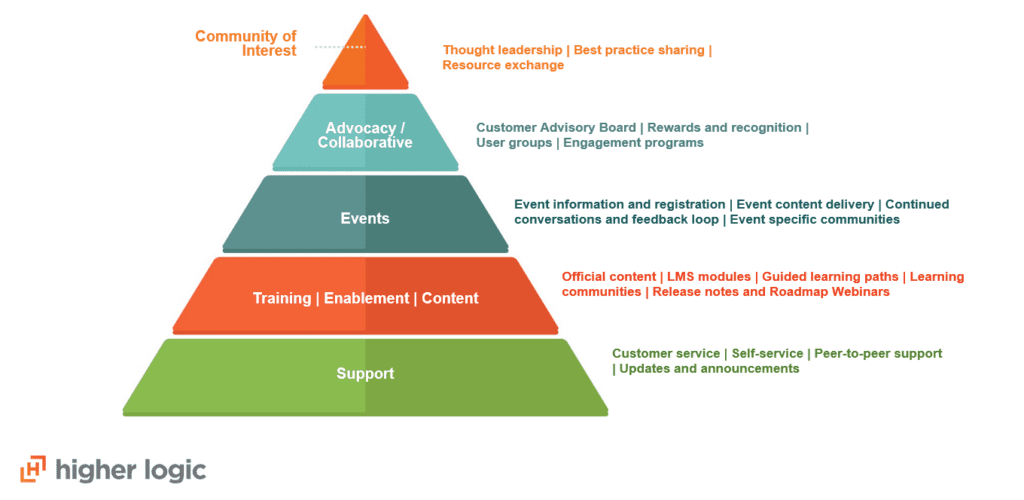
Customer Communities: More Than Case Deflection
It’s time to bust the myth that customer communities only do customer support. Learn how a community can support your company across the customer experience.
Customer support communities are great. If you have one, you know how helpful it can be in onboarding customers, housing answered support questions, and deflecting tickets.
But times are changing. Your customers have higher expectations than ever before. They need and want more than just technical help. They want the type of help that when they get it, creates product adoption and increases their investment in your product.
Can your B2B customer community provide this type of support?
We find that a lot of support communities can only provide “break-fix” solutions. Users come in, get an answer, then leave. They aren’t sticking around to network, swap strategy ideas, or talk industry trends.
You see, a truly engaged customer community that will satisfy customer needs and expectations has to be more than a support forum.
There’s so much of the human element in online community building. Customers need to feel that they are being served and able to succeed when they become a customer, and an online community is how you provide that real support and create that real feeling.
A customer community should create a network of customers. A customer community should centralize content in one easily accessible location. A customer community should help customers answer their strategic questions.
Ultimately, your community should become a destination where customers want to linger, rather than just a “pop in, find an answer, and get the heck out of there” type of place, because they know there’s so much more to the community than that.
If you’re on the fence, stay with me. If you’re bought in, great. Let’s talk practically – how can you evolve your support community?
How to Evolve Your Support Forum to a Community
If you’re starting with the basics, a support forum or customer portal, that’s great – it’s one of the essentials of community. But as your community evolves, you can build on top of that.

Self-Service
In this model, you’re starting with peer-to-peer support or customer self-service as the foundation of the pyramid. You’ll generally use the community to cut support costs as it helps you scale customer support. (Keep in mind that the size of the layer doesn’t mean one is more important than the other – it’s more about the order in which we generally see communities grow.)
Training & Enablement
A very natural next step to customer self-service is training and enablement – because our goal as SaaS companies is to make our customers successful as quickly as possible so that they stick around and invest more.
To accomplish this with community, we see companies start to incorporate training and enablement materials into the community. You might share your knowledge base articles, whether those are hosted by a third party or created right in your community. You might incorporate your learning tracks to help customers get onboarded, or you might post your release notes and roadmap updates.
Events
Whether your events are virtual, in-person, or a mixture of the two in 2021, a community provides a valuable element of longevity to your event. When you think about all the work and effort that goes into creating an event, and all the brainstorming and networking that happens at the event, it makes sense to keep that momentum going by extending the conversation in your customer community.
Advocacy
Support communities used to be wholly owned by support – but now, companies are recognizing that customer communities are perfect for finding and nurturing and rewarding customer advocates. A community is a great place for sustaining engagement with and between your customer advisory board or MVPs or beta testers for new products.
Community of Practice
A typical support forum tends to be more about your platform and technical things about the platform. Sometimes strategy topics come up, but with your standard support portal, that’s a rarity. With an engaged customer community, you start to see communities of practice (or a community of interest) pop up, like within our own customer community, the Higher Logic Users Group, we have a community dedicated to the topic of community management. You might see communities of interest pop up around a certain market vertical or topic.
Product Updates & Ideation
Everything mentioned above leads to great insights for your product team. Your community is a window for your product team to understand customer needs and insights around your product – driving your roadmap and helping you beat the competition.
Get Practical: How to Engage Customers in the Community
All the above begs the question of how to actually create this engaging destination.
One of the best ways to ignite engagement in your customer community is to integrate the community with your customer database. For example, if you use Salesforce as your CRM, the data within Salesforce will help you power that personalized customer journey in the community.
On the first day a new customer logs in, you can set your community up so that they see the product community and information that’s relevant to them, or maybe an upcoming event which fits their profile. They receive an automated welcome email with information specific to their industry. The online community platform logs their interests and starts personalizing the daily email digest they receive.
Once the customer starts interacting in the community, the community can capture the data and write it back to your CRM. If they’re interacting with information about a new product, you can use that data to place them into an ongoing customer marketing campaign. Or you might use this to trigger activity in Gainsight. If you start to understand that engaged community members show higher NPS scores, you can evolve your strategy to get less engaged customers even more engaged.
With hope, you’re starting to see how you can power an engaged customer journey through your community – and how a community can lead to so much more than just improved customer support.
If you’re looking for more guidance on online community engagement, don’t miss our Guide.
Engaged Customer Communities Create Customer-Centric Companies
So how do these engaged customer communities help you improve the customer experience? As your customers encounter a personalized customer journey through the community, able to connect and access the people and resources they need to succeed with your product, their investment and loyalty will grow.
Customer communities help you:
- Make customer-centric processes a reality as you provide personalized education and onboarding
- Build trust as you engage with customers and listen to their concerns
- Encourage participation from your most active customers and grow them into advocates, rewarding and recognizing them for their participation
All of these things add up to create those renewals and make your product stickier. Chris Detzel, Global Enterprise Community Manager at Imperva, is proving this firsthand with a community webinar program he created this year.
His community webinar program covers product roadmaps, expert interviews, Ask Me Anything-style sessions, and new product launches. He’s used Higher Logic to automate the registration and follow-up process. Once the webinar is over, Chris creates even more opportunities for engagement by turning webinars into digestible videos, discussion threads, product Q&As, and product blogs. With each event, the company gets a new wealth of content and SEO opportunities that increase their reach and create value for the Imperva community.
Chris said, “Customers want to know more about our products. We go in-depth in the product, show customers things they might not know they can do, and give them a chance to ask questions. We know when customers engage with us this way, they get excited about all the ways Imperva can help them – going deeper within the products and buying more.”
By creating exciting and engaging community programming, Imperva is increasing high-value customer engagement that they’re already seeing lead to renewals and upsells.
“I was talking to a customer a few months ago, and he wasn’t planning on renewing. He attended one of our community webinars and realized he wasn’t getting enough value out of the product because he wasn’t using every feature. Now, not only is he renewing, but he wants to addon with a second product.”
Chris Detzel, Global Enterprise Community Manager, Imperva
If you already have a support community, and you’re looking to expand from one use case to another, you can actually do this all within one online community platform.
Jama Software is an example of a SaaS company that started with support as the goal of their community (and it worked well – they saw a 28% reduction in support tickets in part thanks to their community initiative) but they’ve expanded to do even more with community, like provide education, communities of interest, and more.
Platforms like Higher Logic’s Community allow you to support customers, but also have the automation and personalization and integration capabilities you need to move from support forum to engaged destination.
Partner Across Departments to Create a Robust Community
You might be wondering how to put this into action at your own company. Sometimes it can feel like it takes a village to build a community.
Who you’ll need to work with all depends on your own org chart and budget, but if you’re wanting to evolve your community from forum to destination and realize more of those topline benefits of community, it often does make sense to partner with other departments.
Of course, it’s not that you necessarily need to have a team of allies when you begin the community journey, especially if you are starting with a support-centric use case. Starting with one use case is just fine.
I love this quote from our customer at Code42, Renee Schaefer – in her explanation of customer journey mapping, she said: “Always remember: the customer doesn’t care about your org chart, and the customer certainly doesn’t care about your back-office tools.”
I think this is 100% true for customer community building as well. The more you can collaborate across departmental lines for the customer’s sake, the more customer-centric you can become.
So when it comes to collaborating with other key stakeholders, how do you want to do this?
You can certainly approach this in multiple ways, but here are some ideas.
- If you start with support, you might want to engage with your education and enablement teams to get them involved in providing more of that product adoption angle.
- If you know your marketing team is focused on advocacy in 2021, invite them to start participating in the community or collaborating with you on identifying power users.
- If you have seen lots of product feedback in the community, start engaging with your product team to make these ideas come to life.
Every single one of your customers will have a different set of needs. And the more you can collaborate internally to make your community a place that meets lots of different needs, the more customer-centric your community and your company will become.


